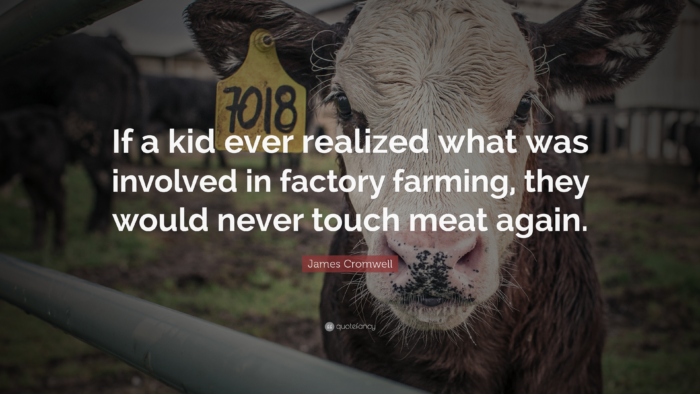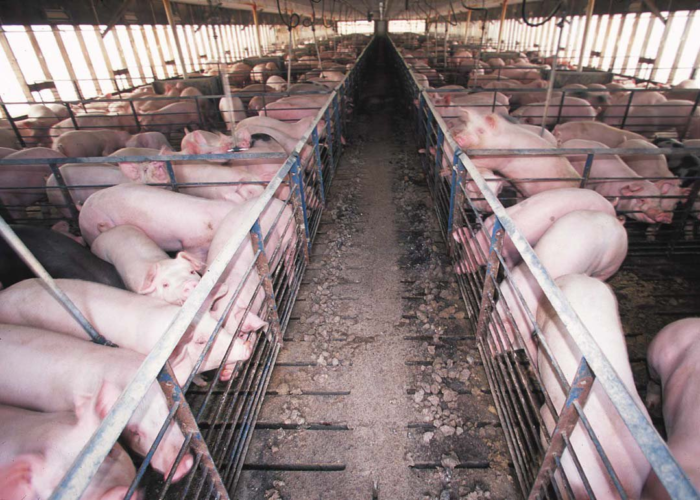By Shawrna Sen
It is a necessity for human beings to eat in order to survive. But there should be a clear distinction between what is food and what is “not food.” Can you take a guess as to how many land animals are killed every year for meat, eggs and dairy in the United States? One might say 200 million, 500 million or 1 billion, but the actual number is shocking. In the United States alone, 10 billion land animals are killed every year for food, and that is excluding the animal proteins taken from oceans and rivers . This huge number of animals raised and killed for food definitely has negative effects on the environment and our health. Not to forget that the ways animals are treated in factory farms is nothing other than cruelty.
So first, let’s dive into factory farming basics.
When we go to buy groceries, the advertised image of the farm is like so: green grassy hills, with large areas where cows are freely walking around. But is that the reality of the massive commercial factory farms that exist in the United States? Absolutely not! Animals are kept in intensive confinement. There is absolutely no space for the animals to even turn around. These animals spend their short lifespans in a horrible environment which is not safe for them at all. They experience the additional stress of being kept in conditions that are so filthy that it is difficult for these animals to survive, which makes them vulnerable to dangerous viruses and bacteria.
Moreover the ethical/moral principles are completely lost at these factory farms. A calf is separated from its mother assoon as it is born so that the factory owners can sell more of its mother’s milk for profit. Cows and pigs are artificially inseminated to produce more animals for food and dairy. Moreover, when these animals can no longer tolerate the physical and mental torture, they are sent off to slaughterhouses to be killed for food.
Chickens are fed growth hormones which makes them grow twice as large in half the time. This puts severe stress on a chicken’s organs, and also prevents it from walking since its legs can’t carry that weight. Ask yourself if you truly want to eat meat that has been harvested using violence against animals. Our job as humans is not to ruthlessly exploit animals, our environment, or ourselves!
Factory farms are extremely damaging to our environment. The animals raised there need to be fed and the foods given them (input) does not equal the amount of meat we receive (output). It is estimated that If people reduced their meat consumption by one half, we could feed everyone on Earth including two billion extra people. Growing crops such as corn and soy to feed meat animals requires a lot of clean water, and this is not a smart investment especially when we think of the global need to conserve and protect drinkable water.
Furthermore, the waste products of these animals require disposal in toxic landfills or sewage systems, from which toxins can leak out to contaminate drinking water and otherwise pollute our environment. The digestive waste produced by 10 billion animals is 50 times as much urine and feces produced by the entire human population of the United States. Additionally, large land areas are required to cultivate these billions of animals, and therefore trees are cut down (deforestation) to create yet another impact on our environment.
Excessive meat eating is also dangerous to human health. 80% of all the antibiotics made in the U.S are used for animals in these factory farms, because Intensively packing animals into small spaces allows diseases to spread rapidly from one to another. To prevent this, antibiotics are fed to animals on a regular basis. The overuse of antibiotics in the animals we eat increases antibiotic resistance in humans, and this is a major medical concern for modern societies. Moreover, the major causes of death in the United States include heart disease, cancer, stroke, and diabetes, and eating too much meat is thought to be a primary cause of these diseases. Fully cutting back on meat consumption reduces the risk of heart disease by 32%. A plant-based diet that also restricts processed food and additives can reverse diabetes better than the diet prescribed by the American Diabetes Association. Additionally, processed meat falls into the first category of carcinogens that causes cancer.
The solution to all these detrimental effects p of meat eating is simple and clear—a plant-based diet! A plant-based diet offers more nutrients than a meat-based diet. According to research at Oxford University which tested 33,883 meat eaters and 41,546 non-meat eaters, the latter group had fewer vitamin deficiencies. Vegans were found to lack iodine, calcium and vitamin B12. Meat eaters were found to lack calcium, and iodine plus five more crucial dietary needs. However, as we know, vitamin B12 is an important nutrient and this is found in meat because animals are given vitamin B12 supplements. Vegans can easily take supplements or foods that are fortified with B12 too (such as Oatly oat milk), to get this vitamin in an adequate amount.
Initially taking small steps to transition from a meat-based diet to a plant-based diet is the single most important step that we as a country and as individuals, can take today to insure a better, healthier future.

